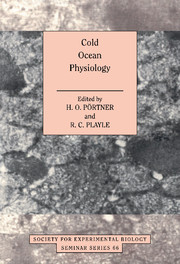Book contents
- Frontmatter
- Contents
- List of contributors
- Preface
- PART I General concepts
- PART II Compensatory adaptations in cold ocean environments
- Adaptation to cold and depth: contrasts between polar and deep-sea animals
- Temperature and growth rates as modulators of the metabolic capacities of fish muscle
- Energetic aspects of cold adaptation: critical temperatures in metabolic, ionic and acid-base regulation?
- Physiological and evolutionary aspects of myoglobin expression in the haemoglobinless Antarctic icefishes
- Oxygen transport systems in extreme environments: multiplicity and structure-function relationship in haemoglobins of Antarctic fish
- Membrane lipid and protein adaptations in Antarctic fish
- Kinetics of enzymes in cold-stenothermal invertebrates
- Effects of low temperature on prooxidant processes and antioxidant defence systems in marine organisms
- PART III Exploitative adaptations
- PART IV Integrative approaches
- PART V Applied approaches
- Index
Effects of low temperature on prooxidant processes and antioxidant defence systems in marine organisms
Published online by Cambridge University Press: 13 March 2010
- Frontmatter
- Contents
- List of contributors
- Preface
- PART I General concepts
- PART II Compensatory adaptations in cold ocean environments
- Adaptation to cold and depth: contrasts between polar and deep-sea animals
- Temperature and growth rates as modulators of the metabolic capacities of fish muscle
- Energetic aspects of cold adaptation: critical temperatures in metabolic, ionic and acid-base regulation?
- Physiological and evolutionary aspects of myoglobin expression in the haemoglobinless Antarctic icefishes
- Oxygen transport systems in extreme environments: multiplicity and structure-function relationship in haemoglobins of Antarctic fish
- Membrane lipid and protein adaptations in Antarctic fish
- Kinetics of enzymes in cold-stenothermal invertebrates
- Effects of low temperature on prooxidant processes and antioxidant defence systems in marine organisms
- PART III Exploitative adaptations
- PART IV Integrative approaches
- PART V Applied approaches
- Index
Summary
Oxidative stress and antioxidant defence
It has only recently become apparent that the highly energy-efficient aerobic metabolism carries the risk of oxidative stress, i.e. uncontrolled liberation of deleterious reactive oxygen species (ROS) into tissues and body fluids, owing to an imbalance between ROS producing prooxidant processes and ROS scavenging antioxidant defence. By superimposing the controlled basic ROS liberation, which regularly accompanies uptake, transport and reduction of oxygen, the phenomenon of oxidative stress literally represents the drawback of oxygen consuming heterotrophic life. As one of the basic effects, oxidative stress leads to an impairment of the well-adjusted cellular redox balance. The latter is based on the ratio of reduced to oxidised glutathione, which is enzymatically coupled to the NAD : NADH system and acts as a redox buffer, protecting functional thiol groups from oxidation to disulphide (Sies, 1985). This redox buffer is essential in counterbalancing oxygen radicals and will be overpowered if the oxidative stress prevails for too long. Oxidative stress accompanies various generally stressful conditions like hypoxia, ischaemia, and intoxication and can interfere with a number of metabolic reactions via oxidation of proteins, membrane lipids, and nucleic acids.
Apart from more general physiological consequences like ageing and the promotion of carcinogenesis, oxidative stress may affect elementary and life supporting cellular structures as oxygen binding blood pigments and ion and proton transporters in plasma membranes.
Cellular antioxidant defence is generally accomplished by a complex antioxidant system, the capacity of which can be modulated and adjusted during periods of increased oxidative stress (by augmenting antioxidant enzyme activities).
- Type
- Chapter
- Information
- Cold Ocean Physiology , pp. 212 - 236Publisher: Cambridge University PressPrint publication year: 1998
- 19
- Cited by

